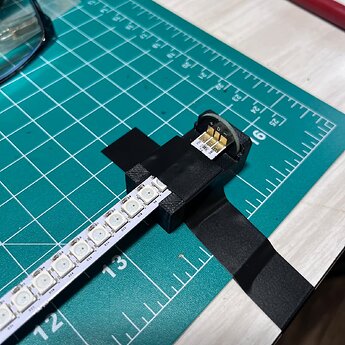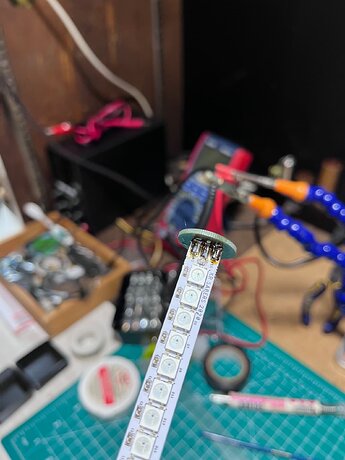So as to not hijack the other thread:
Well, the case of the KR strip the current flow is arranged so that it ends up like:
I originally built this as a show blade for a thin-neck Obi, but chose a thick walled blade and the balance is awful. Error.
In my regular saber this blade is incredibly balanced, leading to less drops. But each of those drops carries the weight of more anxiety. Blades are expensive.
Does the mass of the semi-rigid strip nullify enough force to compensate for the flexibility of normal strips and wiring? I have no idea, but there seems to be at least inter-equivalency. The direct solder pcb is about as tough as the KR strip.
I’m starting up project based learning and many kids are handling this set up. When one young Jedi over swung (in the very safe designated area with my direct supervision) and hit the floor, my heart skipped a beat over the blade. It was fine but I might swap it out for my old blade. Maybe I should make a 7/8 ultra light with an adapter that’s just for the kids…
If you go this hard or above, flexible strips are the way to go:

I don’t know for sure. Rigid pixel strips have a pretty spotty history. At least some of them have been very very brittle. And more mass means more momentum when you drop something.
The solder joint itself seems like it would have the same problem: It’s more ridgid, which means it’s more likely to crack. However, this is all based on my intuition, I don’t have any math or data to back it up, and I could absolutely be wrong.
I really like the idea (if it is reliable enough) since it reduces the amount of soldering, number of parts, and the amount of “cramming” you have to do in the blade.
1 Like
$2.99 at TCSS. An easy add to cart.
@profezzorn thats how Bendu Armory and now TCSS have done their normal strip blades for a while now: direct soldering, as I understand from this description.
Bendu’s tree video is his general rebuttal to it not being strong enough… probably because most of the shock is actually up higher in the blade, and between everything else it’s substantially dampened by the time it gets to the rigid joint.
Probably not much different than normal with wires… like you however I have no personal testing.
And of course that’s still with normal strips. When the blade is a PCB all the way through it probably becomes the greater risk rather than the connection.
2 Likes


